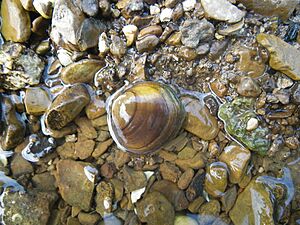Round hickorynut facts for kids
Quick facts for kids Round hickorynut |
|
|---|---|
 |
|
| Conservation status | |
| Scientific classification | |
| Genus: |
Obovaria
|
| Species: |
subrotunda
|
The round hickorynut (Obovaria subrotunda) is a special type of freshwater mussel. It's an aquatic bivalve mollusk that lives in rivers. Think of it like a clam, but it lives in fresh water, not the ocean! These mussels belong to a family called Unionidae, which are also known as river mussels.
Contents
What is a Mussel?
Mussels are amazing creatures that live in shells. They are part of a group called mollusks, which also includes snails and octopuses. Mussels have two shells that are hinged together. This is why they are called "bivalves" – "bi" means two, and "valve" means shell.
What Does it Look Like?
The round hickorynut mussel has a shell that is, you guessed it, quite round! It's usually a brownish or yellowish color. The shell is smooth and thick, helping to protect the soft animal inside.
Where Do They Live?
This mussel makes its home in the eastern parts of North America. They prefer to live in rivers and streams that have clean, flowing water. They often bury themselves partly in the sand or gravel at the bottom of the river.
What Do They Eat?
Mussels are like natural water filters! They eat tiny bits of food floating in the water. They do this by drawing water into their shells and filtering out plankton and other small particles. This process helps keep the water clean for other animals and plants.
Life Cycle and Reproduction
The life cycle of freshwater mussels is quite unique. Unlike many animals, they need fish to help their babies grow up!
How Babies Are Made
Female round hickorynut mussels release their larvae, which are called glochidia, into the water. These glochidia are very tiny and need to attach themselves to the gills or fins of certain fish species. They don't hurt the fish, but they use the fish as a safe place to grow.
Growing Up
After a few weeks, the glochidia change into tiny juvenile mussels. They then drop off the fish and settle onto the riverbed. From there, they start to grow into adult mussels, slowly burying themselves in the sand or gravel.
Why Are They Important?
Freshwater mussels play a super important role in their ecosystem. They are like the kidneys of the river!
- Clean Water: By filtering water, they remove pollutants and tiny particles, making the water clearer and healthier.
- Food Source: They can be a food source for other animals, like muskrats and some birds.
- Habitat: Their shells can provide shelter for small insects and other creatures on the riverbed.
Conservation Status
Sadly, the round hickorynut mussel is in trouble. Its numbers have been going down, and it needs our help to survive.
Endangered in Canada
In Canada, this mussel is listed as an endangered species. This means it's at very high risk of disappearing forever from the wild in Canada. The Canadian Species at Risk Act helps protect animals like the round hickorynut.
Threatened in the United States
In the United States, the round hickorynut was listed as a federally threatened species in 2023. This means it's likely to become endangered in the near future. The Endangered Species Act in the U.S. helps protect these animals and their homes.
Why Are They Disappearing?
Many things can harm mussels:
- Water Pollution: Chemicals and dirt from farms and cities can make the water unhealthy.
- Habitat Loss: Rivers being changed for dams or development can destroy their homes.
- Invasive Species: New species brought into the area can compete with mussels for food or space.
How Can We Help?
Protecting the round hickorynut mussel means protecting our rivers!
- Support efforts to keep rivers clean and healthy.
- Learn more about freshwater mussels and share what you know with others.
- Reduce pollution in your own community.


